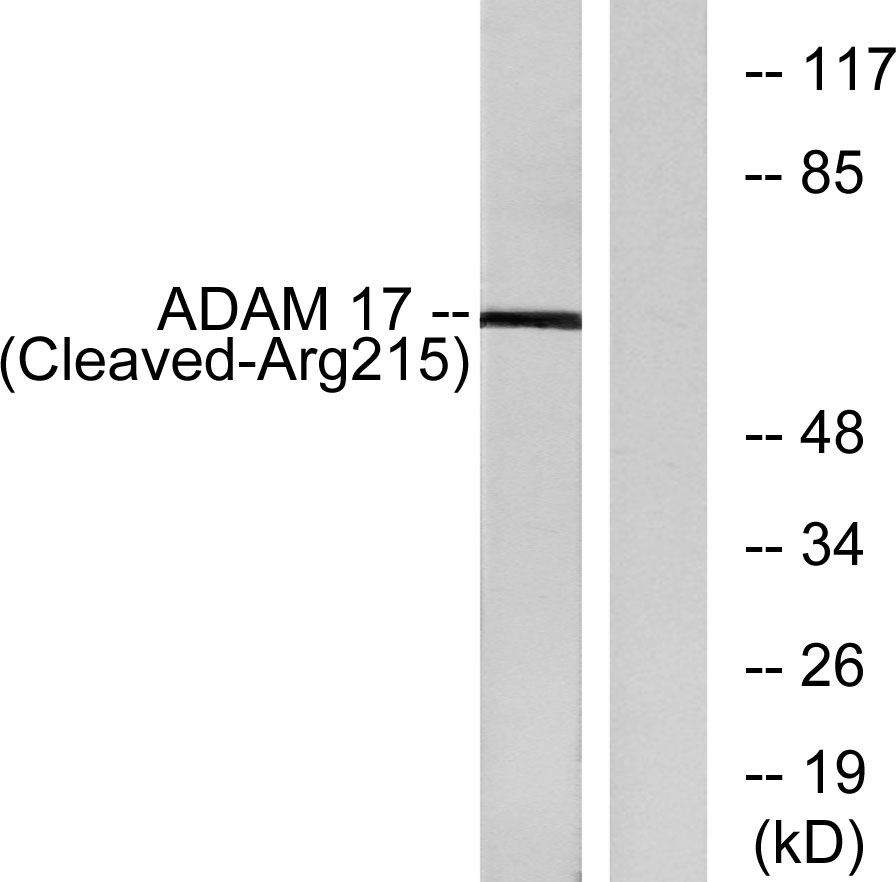- 靶点:
- TACE
- 简介:
- >>Notch signaling pathway;>>Alzheimer disease;>>Epithelial cell signaling in Helicobacter pylori infection;>>Coronavirus disease - COVID-19
- 基因名称:
- ADAM17
- 蛋白名称:
- Disintegrin and metalloproteinase domain-containing protein 17
- Human Gene Id:
- 6868
- Human Swiss Prot No:
- P78536
- Mouse Swiss Prot No:
- Q9Z0F8
- 免疫原:
- The antiserum was produced against synthesized peptide derived from human ADAM 17. AA range:196-245
- 特异性:
- Cleaved-TACE (R215) Polyclonal Antibody detects endogenous levels of fragment of activated TACE protein resulting from cleavage adjacent to R215.
- 组成:
- Liquid in PBS containing 50% glycerol, 0.5% BSA and 0.02% sodium azide.
- 来源:
- Polyclonal, Rabbit,IgG
- 稀释:
- WB 1:500 - 1:2000. ELISA: 1:20000. Not yet tested in other applications.
- 纯化工艺:
- The antibody was affinity-purified from rabbit antiserum by affinity-chromatography using epitope-specific immunogen.
- 浓度:
- 1 mg/ml
- 储存:
- -15°C to -25°C/1 year(Do not lower than -25°C)
- 其他名称:
- ADAM17;CSVP;TACE;Disintegrin and metalloproteinase domain-containing protein 17;ADAM 17;Snake venom-like protease;TNF-alpha convertase;TNF-alpha-converting enzyme;CD antigen CD156b
- 实测条带:
- 65kD
- 背景:
- ADAM metallopeptidase domain 17(ADAM17) Homo sapiens This gene encodes a member of the ADAM (a disintegrin and metalloprotease domain) family. Members of this family are membrane-anchored proteins structurally related to snake venom disintegrins, and have been implicated in a variety of biologic processes involving cell-cell and cell-matrix interactions, including fertilization, muscle development, and neurogenesis. The encoded preproprotein is proteolytically processed to generate the mature protease. The encoded protease functions in the ectodomain shedding of tumor necrosis factor-alpha, in which soluble tumor necrosis factor-alpha is released from the membrane-bound precursor. This protease also functions in the processing of numerous other substrates, including cell adhesion proteins, cytokine and growth factor receptors and epidermal growth factor (EGF) receptor ligands. The encoded protein also plays a prominent role in the activation o
- 功能:
- catalytic activity:Narrow endopeptidase specificity. Cleaves Pro-Leu-Ala-Gln-Ala-|-Val-Arg-Ser-Ser-Ser in the membrane-bound, 26-kDa form of tumor necrosis factor alpha (TNF-alpha). Similarly cleaves other membrane-anchored, cell-surface proteins to 'shed' the extracellular domains.,cofactor:Binds 1 zinc ion per subunit.,domain:Must be membrane anchored to cleave the different substrates. The cytoplasmic domain is not required for the this activity. Only the catalytic domain is essential to shed TNF and p75 TNFR.,domain:The conserved cysteine present in the cysteine-switch motif binds the catalytic zinc ion, thus inhibiting the enzyme. The dissociation of the cysteine from the zinc ion upon the activation-peptide release activates the enzyme.,function:Cleaves the membrane-bound precursor of TNF-alpha to its mature soluble form. Responsible for the proteolytic release of several other cel
- 细胞定位:
- Membrane; Single-pass type I membrane protein.
- 组织表达:
- Ubiquitously expressed. Expressed at highest levels in adult heart, placenta, skeletal muscle, pancreas, spleen, thymus, prostate, testes, ovary and small intestine, and in fetal brain, lung, liver and kidney. Expressed in natural killer cells (at protein level) (PubMed:24337742).
MiR-26a-5p from HucMSC-derived extracellular vesicles inhibits epithelial mesenchymal transition by targeting Adam17 in silica-induced lung fibrosis ECOTOXICOLOGY AND ENVIRONMENTAL SAFETY Lin Tian WB,IHC Mouse lung tissue MLE-12 cell
货号:YC0076
- June 19-2018
- WESTERN IMMUNOBLOTTING PROTOCOL
- June 19-2018
- IMMUNOHISTOCHEMISTRY-PARAFFIN PROTOCOL
- June 19-2018
- IMMUNOFLUORESCENCE PROTOCOL
- September 08-2020
- FLOW-CYTOMEYRT-PROTOCOL
- May 20-2022
- Cell-Based ELISA│解您多样本WB检测之困扰
- July 13-2018
- CELL-BASED-ELISA-PROTOCOL-FOR-ACETYL-PROTEIN
- July 13-2018
- CELL-BASED-ELISA-PROTOCOL-FOR-PHOSPHO-PROTEIN
- July 13-2018
- Antibody-FAQs
- 产品图片

- Western blot analysis of lysates from rat liver cells, using ADAM 17 (Cleaved-Arg215) Antibody. The lane on the right is blocked with the synthesized peptide.



